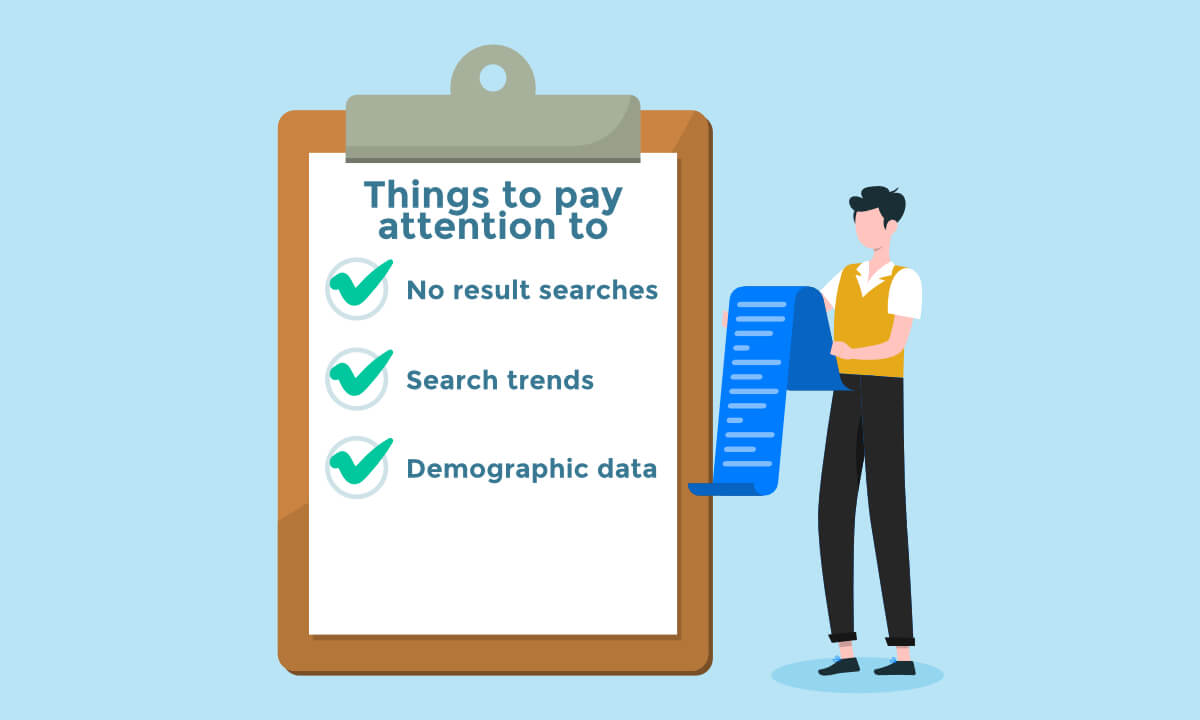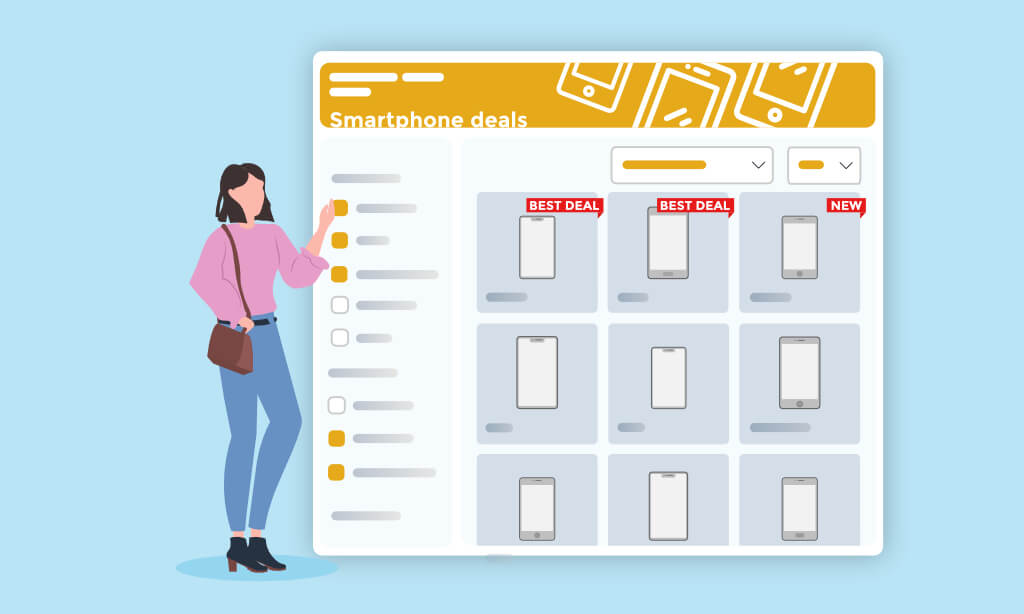Table of contents
“Convert more visitors to buyers.” eCommerce site owners all want this result for their site. Attracting visitors can be tough enough, but visitors who don’t make purchases are not producing income for the business. There are at least 12 steps every eCommerce site owner can take to use site search to convert visitors into buyers.
Searchers Purchase More Often and Spend More Money
We need to make one rule about this heading. Visitors who use search convert more often and spend more money when they find what they want easily and quickly. Research shows shoppers who use search functions convert 7-16 times more often than those who are browsing.
The reason for this increase in conversions is simple. Searchers are at a different place in the buying journey. They already know what they want to buy. eCommerce sites need to ensure they find it quickly and easily.
12 Actions You Can Take to Boost Your Revenue Using Site Search
Getting better results in eCommerce is often about making small tweaks and changes. These 12 steps are not massive website rewrites or brand relaunches. Instead, they are tweaks and changes nearly every site owner can make.
Some steps might require specialized software or support, but there’s guaranteed to be something in this list you can do today to make your site more profitable.
Get Better Data to Make Better Decisions

ECommerce is highly competitive, and everyone is looking for an edge. Your customers can give you the ultimate edge. They will tell you what they want to buy. All you have to do is listen to them and then sell them what they want.
Here’s the simple action you can take today to get better results:
Record and analyze your site search data to discover sales possibilities.
Your search customers are telling you what they want to buy. If you don’t record and analyze site search data, then you’re not listening to these customers. Here are some ways you could use site search data to your advantage:
- Searches that lead to no results can show you new products you could be selling.
- Tracking trends in search can help you plan product listings to capitalize on trends.
- Demographic data, such as location, language, age, and gender of searchers can lead to much more accurate targeting of ads.
Better data leads to better decisions, so start collecting and analyzing your data today.
Help Customers Begin Their Search with Visible and Consistent Search Boxes
Internet users are not patient people. They don’t want to search for your site search box. Make it plainly visible on every page. As your site becomes more complex, this becomes increasingly necessary.
Can you imagine a site like Amazon without a search box?
Thankfully, improving the visibility of your site search box is really simple. Here are the five steps towards a great search box:
- Position it in a normal place. The top center or top right are the normal places. Don’t put it somewhere else without a very, very good reason.
- Give your search box some space. Don’t cram it in next to a newsletter sign-up button or other field. Leave space so it stands out.
- Provide a visual clue. Use a small magnifying glass to show visitors the purpose of your box. If you prefer, you can add a button like “GO” instead.
- Start with a full text field. A full text field is a strong signal about the search box. Most searches fit into a 27-character text box.
- Get the starting action right. Users prefer to hit ‘Enter’ to start their searches, so make sure this works. You can also include a button or icon to launch the search for those who like this method.
These five things will make your search box stand out to your customers.
Use Intelligent Search Autocomplete with Autocorrect
The goal of site search, from the site owner’s perspective, is to match customers to products. Autocomplete can be very effective because it generates search terms that will always lead to products. Autocorrect complements autocomplete by eliminating spelling errors or language inconsistencies.
27% of sites have autocorrect with useability issues, though. Your site’s autocorrect can function better with a few tweaks:
- Display the autocomplete’s suggested terms differently using italics, boldface, or a different font.
- Use an intentionally short list to avoid overwhelming customers – especially on mobile devices.
- Add visual cues to show ‘scoped searches.’ When you’re suggesting a search within a department, make this clear.
- Maximize focus on the search box when autocomplete is active. Use shadows on the rest of the page and avoid clutter with other elements.
There are many other tweaks you can make to your autocomplete function. Use this function to lead customers directly to your products.
Allow Visitors to Search in Different Product Categories
Remember, the goal is to help searchers find what they want quickly and easily. You can do this by adding department or section filters to your search box. A simple filter menu on the left side of the search box can let your users search the entire site or within a specific department.
For example, a clothing site could have a filter menu that included Men’s, Women’s, and Children’s clothing sections. Helping your customers narrow down their search will give them better results. Better results means more sales.
Use Faceted Search to Maximize Search Efficiency
Facets are the details of your products. Some examples of facets include shoe size, product color, and brand name. Give your customers access to these facets as filters to make their search more efficient.
Around 40% of sites do not offer faceted search. These sites are missing out on a tremendous opportunity. Customers who quickly find what they want become buyers. Faceted search helps these customers target their searches intuitively.
Optimize Your Search for Mobile

Browsing and shopping on mobile devices is driving eCommerce to new heights. On Cyber Monday in 2019, 54% of shoppers in the USA used mobile devices. Optimizing your site for mobile visitors isn’t difficult, and it can affect your conversion rates.
Site search for mobile devices should conform to the smaller screen size and lack of a keyboard for text input. Here are a few ways to help your mobile visitors:
- Make the search function obvious on the screen so the shopper can find it easily.
- Store recent searches and allow users to see their search history because this saves the customer on data entry time.
- Use scan and autofill options because people want to save time. Location, credit card scanning, and autocomplete can all help achieve an easier experience for your customer.
We’ve written an entire guide called “The Ultimate Guide to Mobile App Design.” You can check out the chapter on Product Search and Form Entry for more tips.
Searchandising

Searchandising is a term we use for promoting your products through placing ads, product suggestions, and upselling. Brick and Mortar stores call this merchandising. Since we are talking about search, we call it searchandising.
Before we give you some tips to make searchandising work for you, we should point out one rule for all digital marketing:
Keep your data and analyze it to understand your customers.
Once you start moving products around, promoting specific items, and attempting to influence your customers, monitor the results so you know what is working and what may be driving customers away.
That being said, here are some easy searchandising strategies you can implement:
- Move new items or on-brand products to the top of the list because customers may be more interested in these than the item they searched for first.
- Use embedded product suggestions because this is a shortcut to a purchase. Think of it as autocomplete at the next level. Don’t just suggest a search term, suggest the best item.
- Add promotional banners near the search bar because customers looking for the search bar will see the banner.
Here is a link to at least ten more easy searchandising strategies you can explore and implement.
Optimize Your Search Result Pages
Getting results from a search is only the first step towards a purchase. Customers want to find specific items quickly. You can help them by tweaking your search results pages.
There are some visual changes you can make to improve your results page. Try to use the same fonts and text sizes on all the search results. Add dynamic thumbnails to display the best product variation (such as black shirts) to the customer.
You can also implement changes to the way users interact with the search results. Infinite scrolling is better than loading new pages. A floating filter menu that remains visible when the user scrolls is far better than one that disappears during scrolling. Of course, using related searches and filtering are also top priorities.
Never Waste a No Results Page

68% of sites have a no results page that is a dead end for customers. What a waste! You can do better by using 404, or no results pages, to build more trust with your customers.
The primary goal of a good no results page is not to let go of the customer’s hand. You’ve been with them for the first part of their shopping journey. Now, they’ve hit a little barrier. Don’t let go with a generic no results page. Give them some options and help them feel empowered.
There is a simple three-step formula for dealing with a no results search.
- Explain what happened clearly because your customer might overlook the “No Results” message if it is the first line on the page.
- Apologize for the outcome and take responsibility for helping because this will reassure your customer.
- Make a suggestion so your customer feels there is an option that helps them move forward. Suggest a related search query, a similar product, or even a contact method like phone, email, or chat.
The goal is to give your customer a feeling of possibility. If they feel the right product is within their reach with just a little more effort, they’ll stick around.
Optimize Your Search Data Infrastructure

Your customers will never see the infrastructure supporting their search functions. You should see this information and structure regularly. Let’s repeat the simple rule we explained earlier:
Keep your data and analyze it to understand your customers.
Your customers will tell you critical information about which products they like, which ones they won’t buy, and how appealing your offers are to them. If your site search infrastructure is poor, you won’t be able to find the information your customers are giving you.
Here are a few quick things you can monitor:
- Frequently searched terms
- Searches with low CTR
- Performance of top-listed products
- Mobile website data
Monitoring these things will give you a superb view of what your customers want. If you can’t easily track these items, then consider hiring a SaaS product development company that will help you.
Personalize Your Site Search
Site search personalization is like going to the hairdresser. You want your hairdresser or barber to remember you from the last time. eCommerce customers are the same. You can personalize search results by remembering information about the customer.
For example, when a customer searches for an item, a personalized result will suggest something they already purchased and might want again, like a food choice at a supermarket. Another option might be to suggest items in the customer’s size from a clothing site. These minor examples of personalization save your customers time and make for a smoother shopping experience, resulting in decreased abandonment and increased spending.
Improve Your Site Search Speed
Customers want speed. 64% of smartphone users expect load times less than four seconds. 47% of online shoppers want load times lower than 2 seconds. Slow load times increase bounce rates, cart abandonment, and customer dissatisfaction.
Improving your site search speed is a little different from just boosting your overall site speed. To boost search speed, try using compressed images for thumbnails. Display fewer results per page to improve load times. Add filters to make the results more relevant to the user even as you show them fewer results.
The best way to boost site search speed is to improve the search results. Searching twice is always slower than searching once. So great search results on the first attempt is the best solution for faster searches.
Site Search Boosts Revenue
We’ve already said this, but it is really worth repeating. If you nail your site search function, then you can expect your revenue to increase. Average increases of 15% conversion rates and 47% revenue growth are possible. Follow these 12 actionable site search optimizations to earn more money today.




